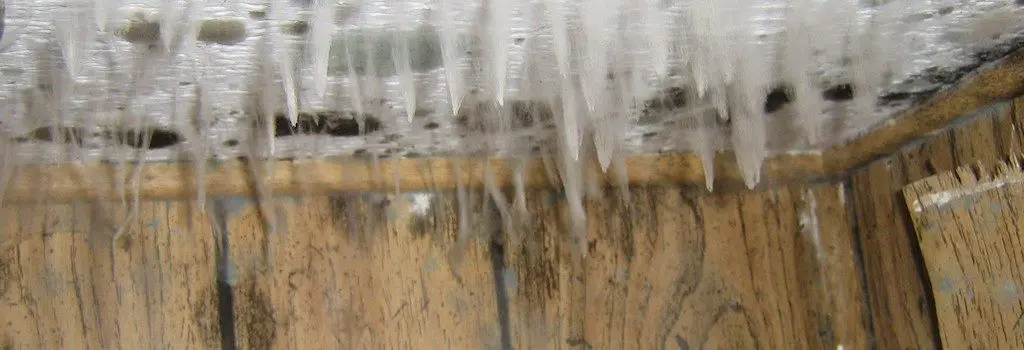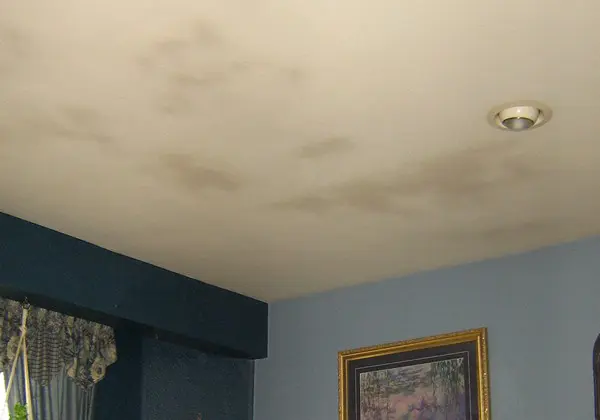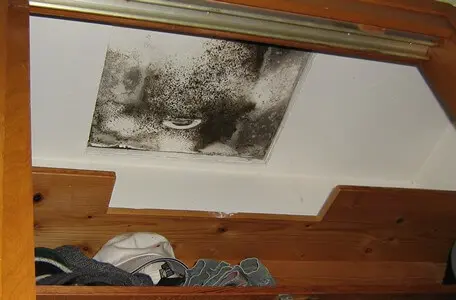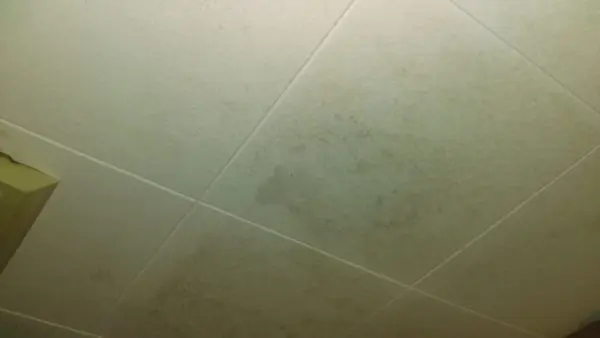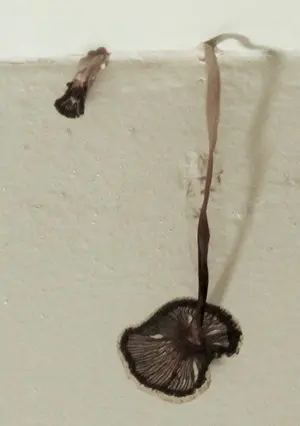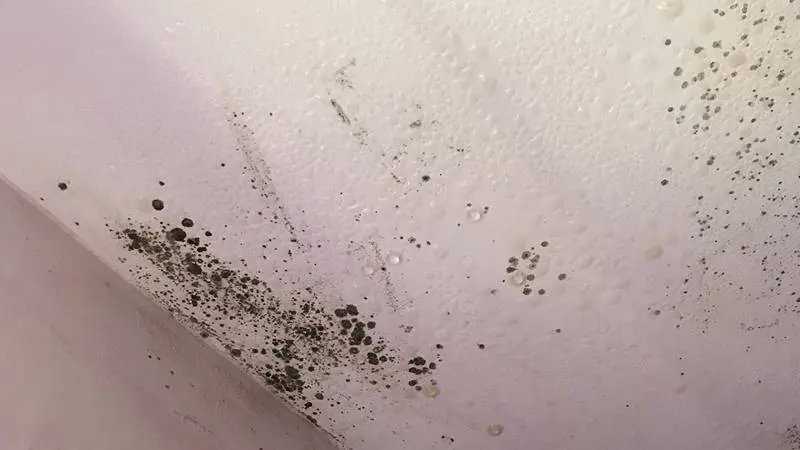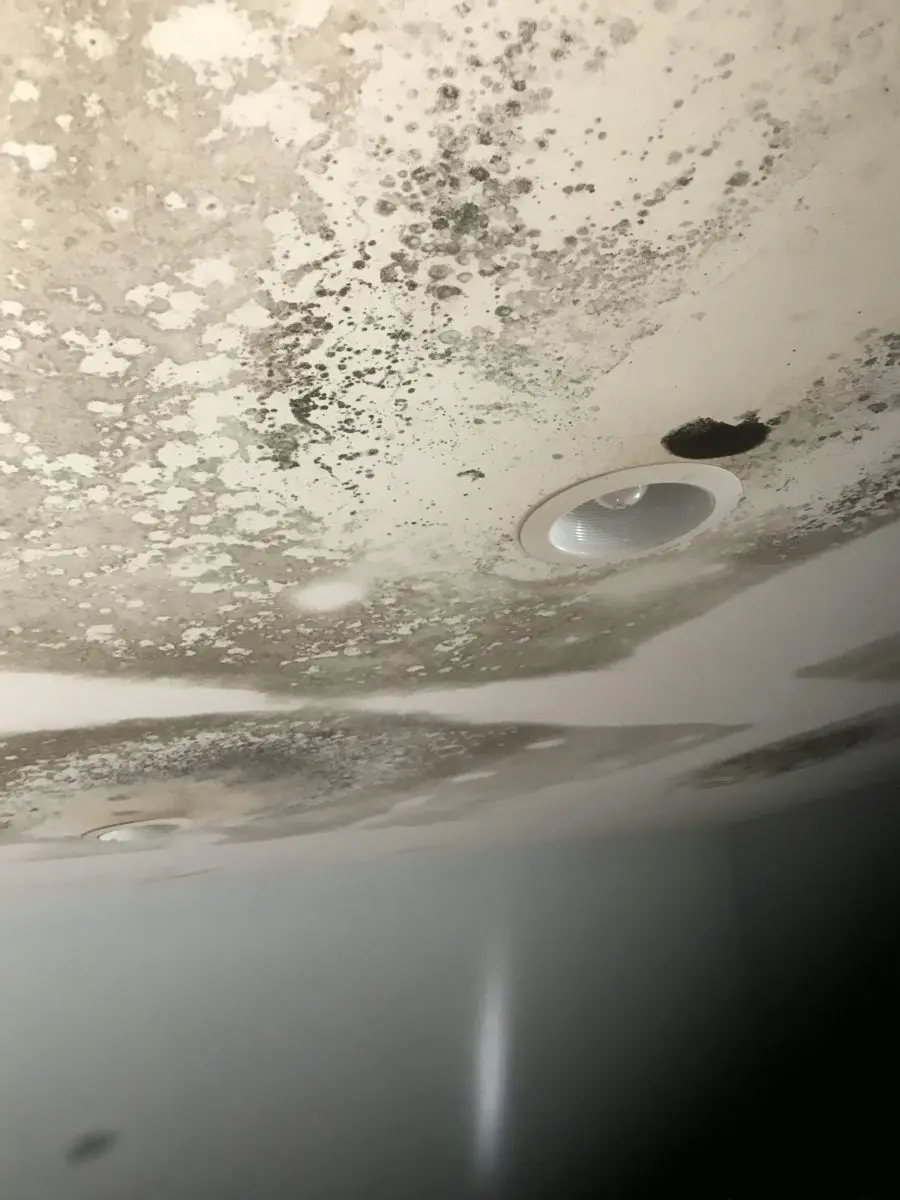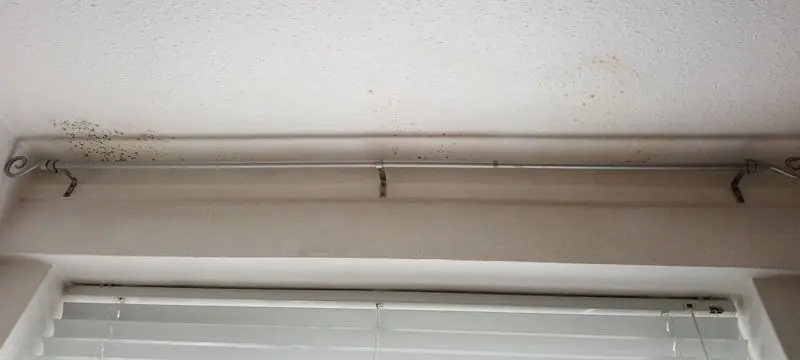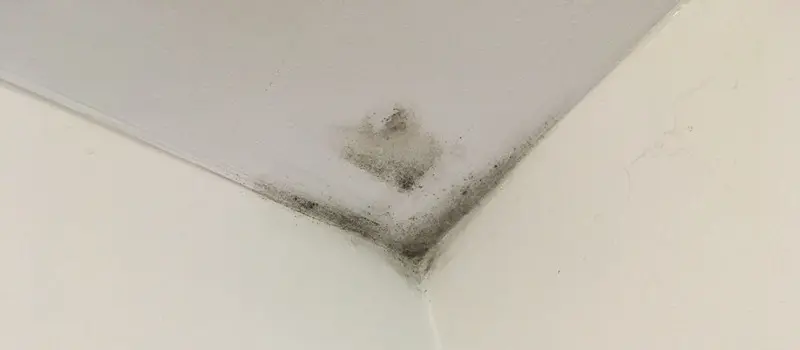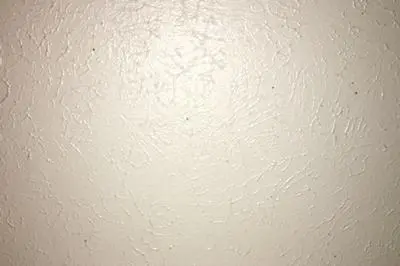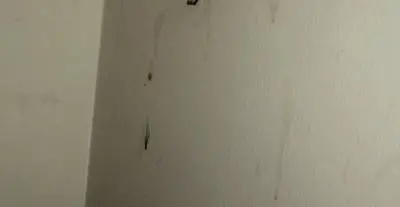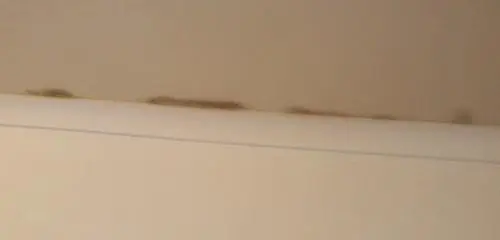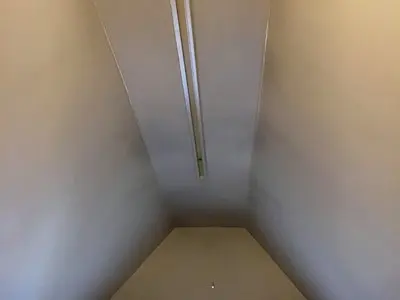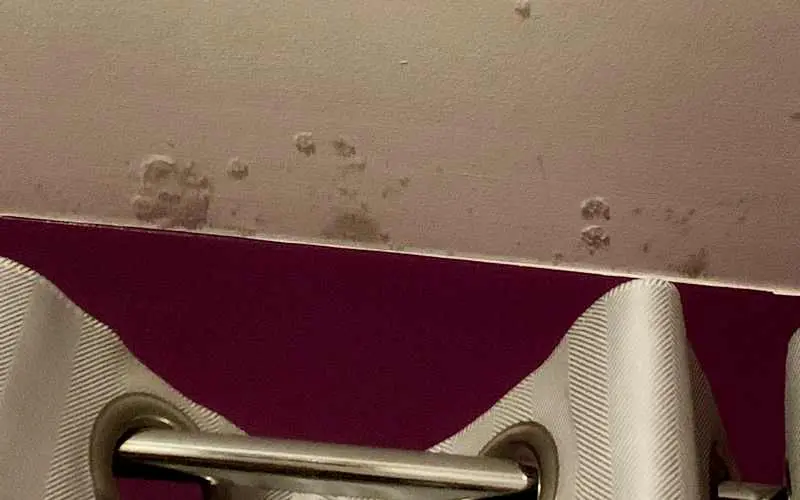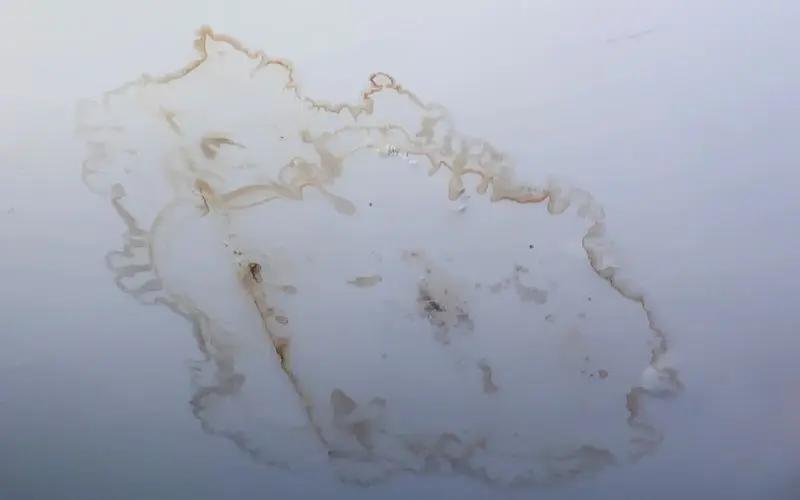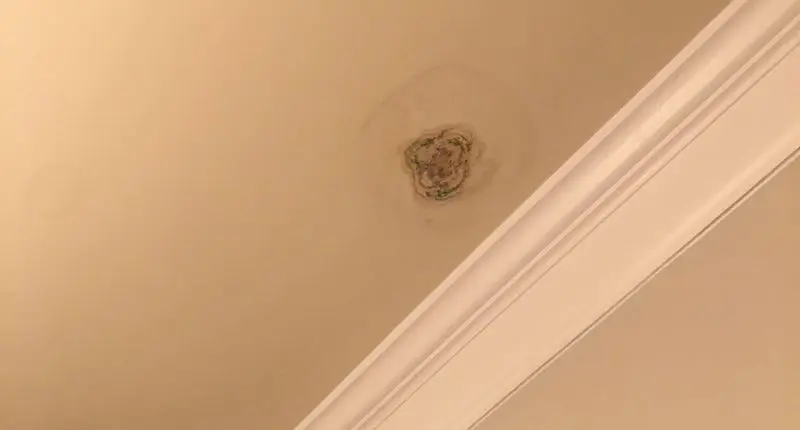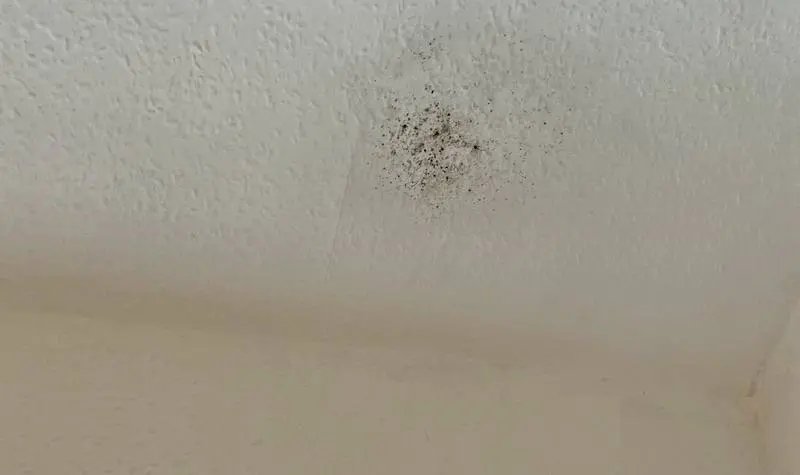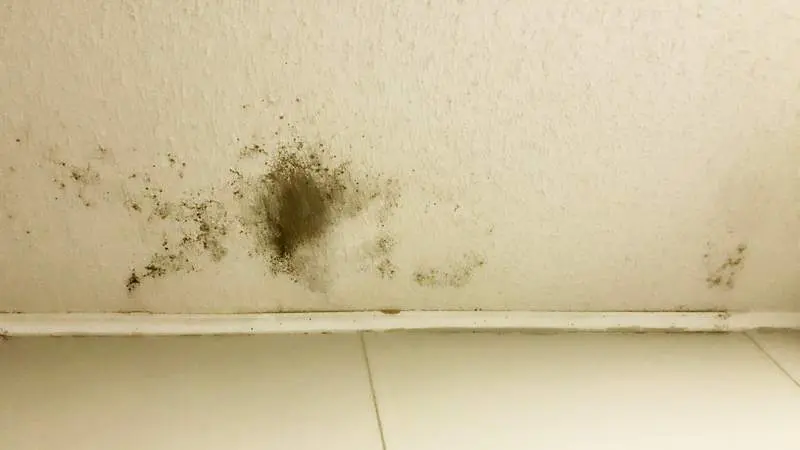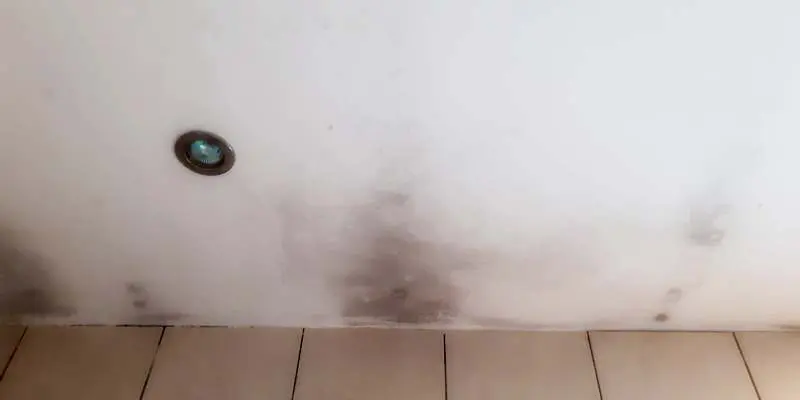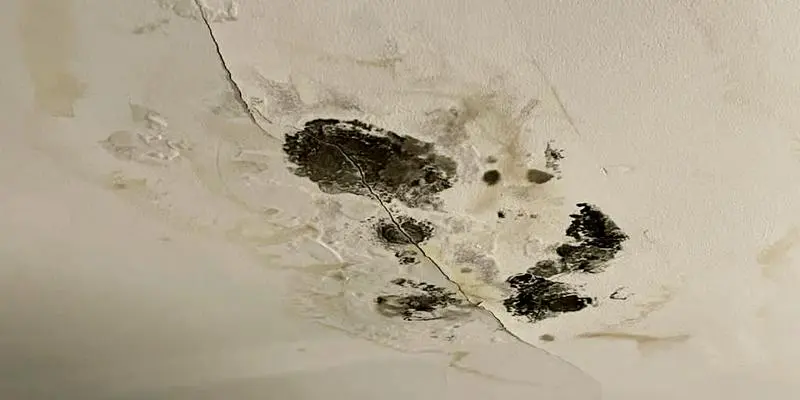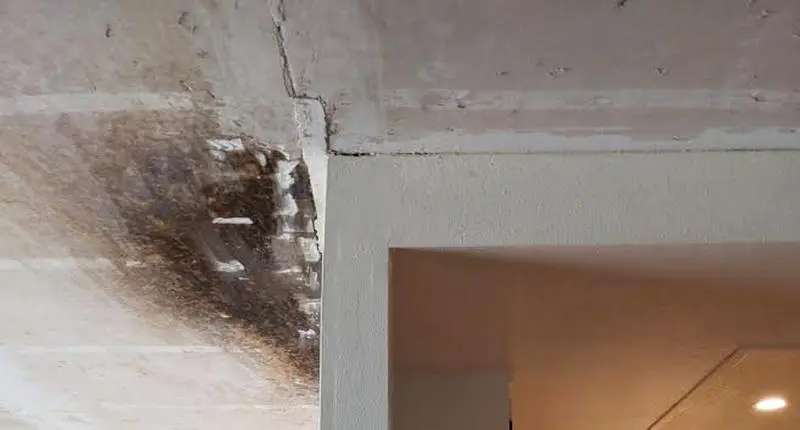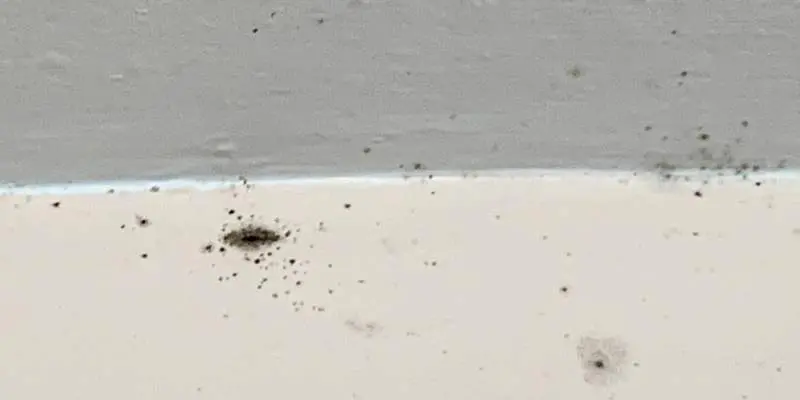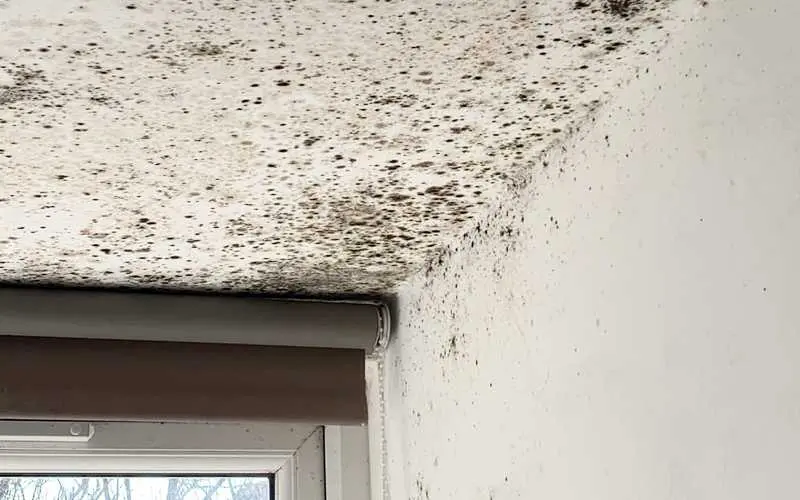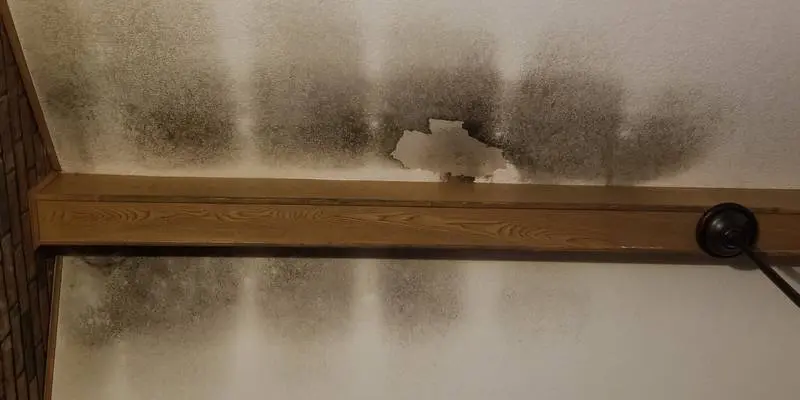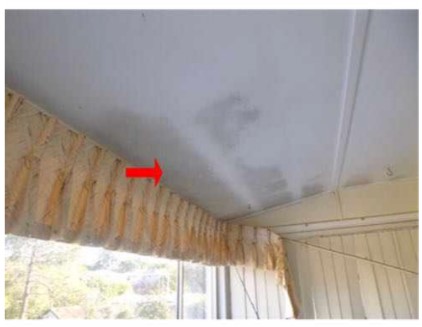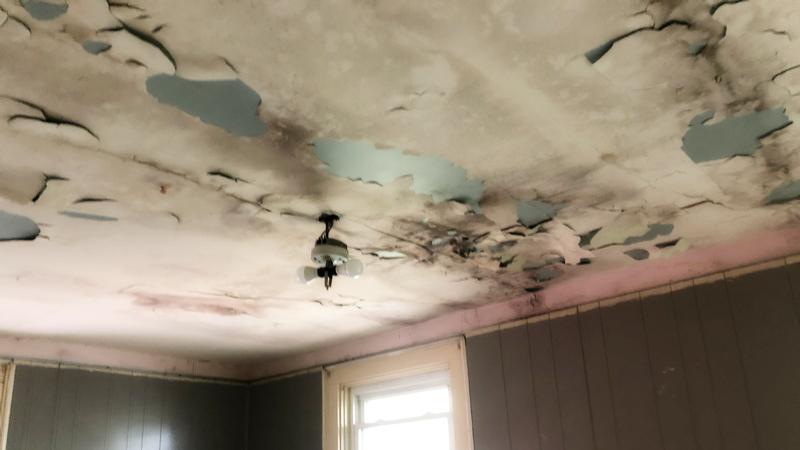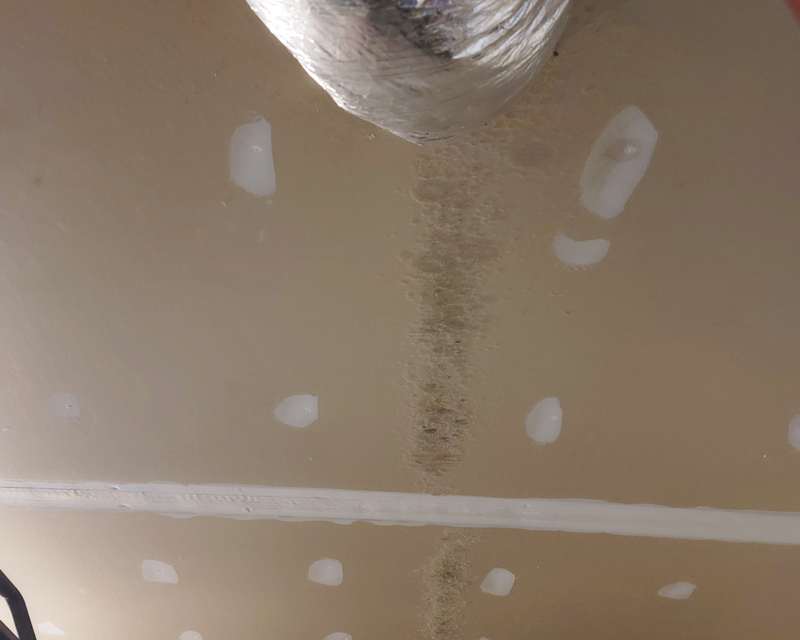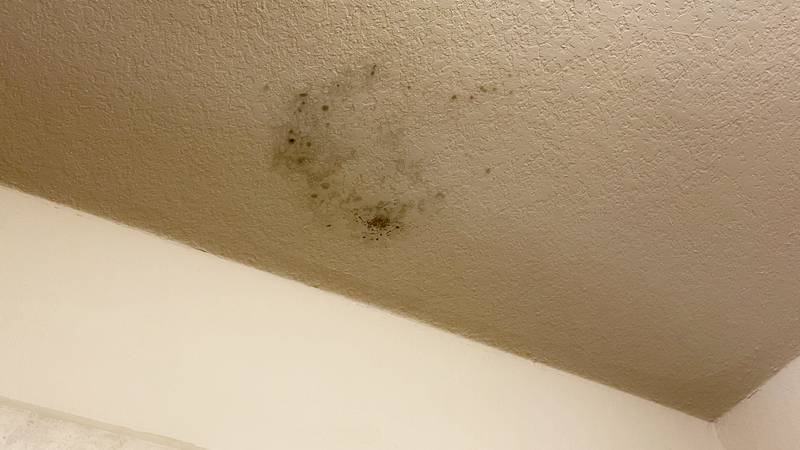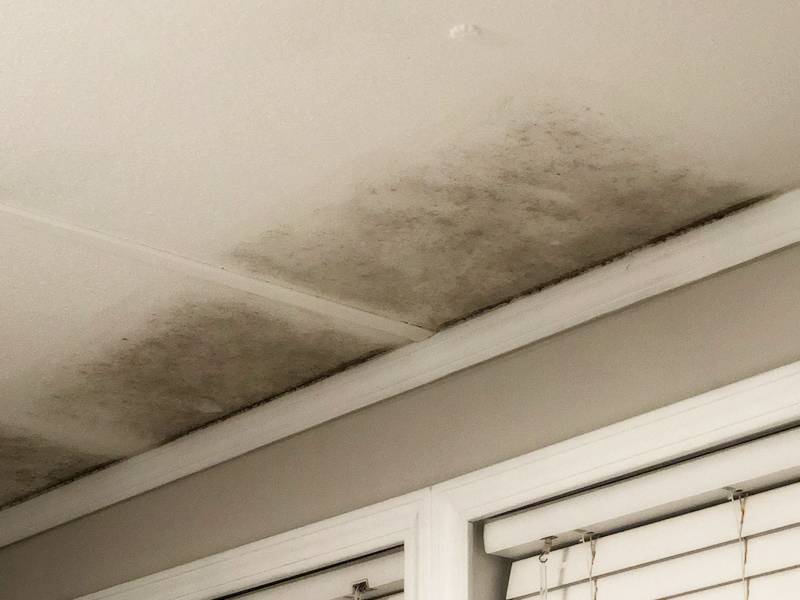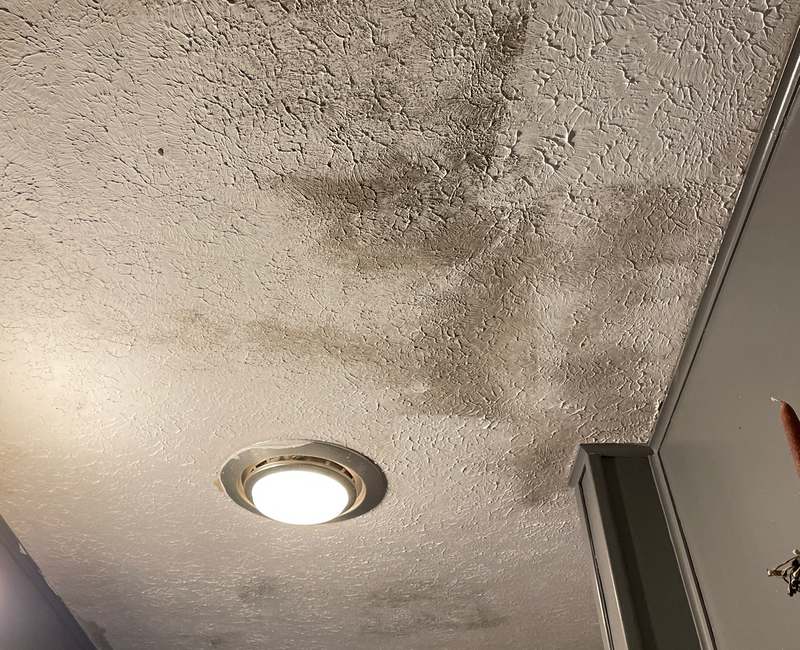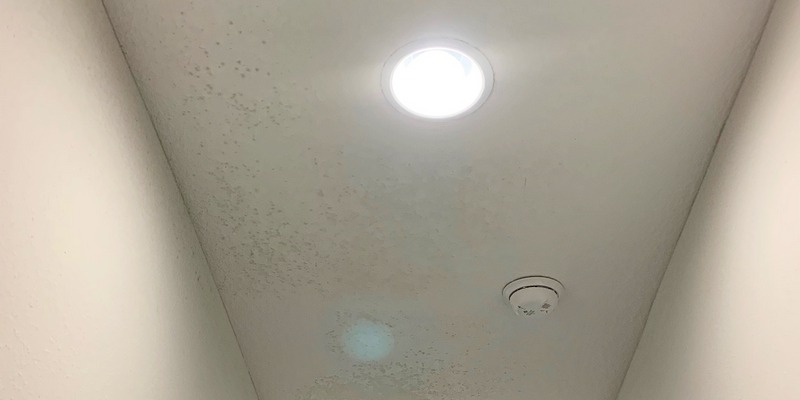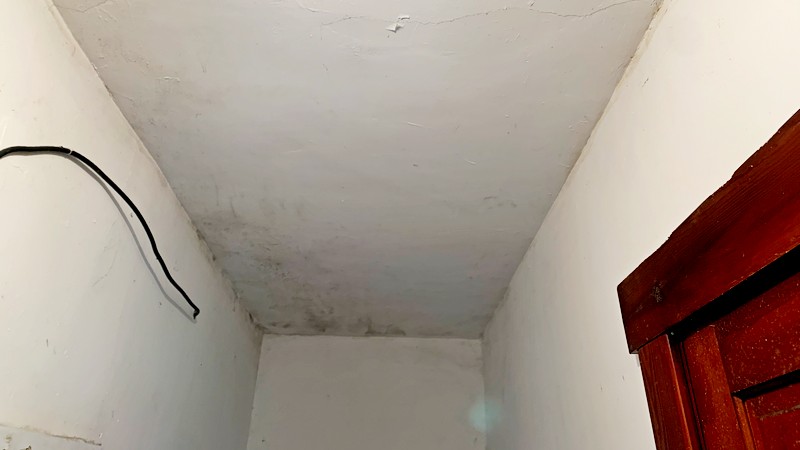Ceiling Mold
Moisture and mold problems can occur on the ceiling for a variety of reasons. For the sake of clarity, let’s look at the most common ceiling problems in two broad categories: 1.) Humidity. 2.) Liquid moisture.
Humidity problems occur when warm, moisture-laden air interacts with a cool ceiling, causing condensation and subsequent interior mold growth. Liquid moisture problems are due to direct liquid water exposure, i.e. plumbing failures, roof leaks, etc.
Occasionally the mold growth is due to a combination of both factors. In the photo above, ceiling mold was due to an extensive flooding event while the home was unoccupied. Although the water never touched the ceiling, the flooded flooring created extremely high humidity throughout the entire home. Over time, mold growth occurred on the ceiling.
First, is it really mold growth?
While mold growth on the ceiling is often obvious, there is another building defect that can look eerily similar. It’s called ghosting. It occurs when soot and dust particles stick to the ceiling. Over time, these particles cause a permanent stain. The clue is in the pattern. Ghosting often appears in perfectly straight lines.
Why? The lines correspond to the framing joists in the attic above. The framing is a worse insulator than the surrounding fiberglass, which passes through to the ceiling below. The colder temperature leads to condensation, which causes the soot and dust particles to stick. Still unsure whether or not you’ve got mold? Read our guidance on mold testing.
Ghosting:
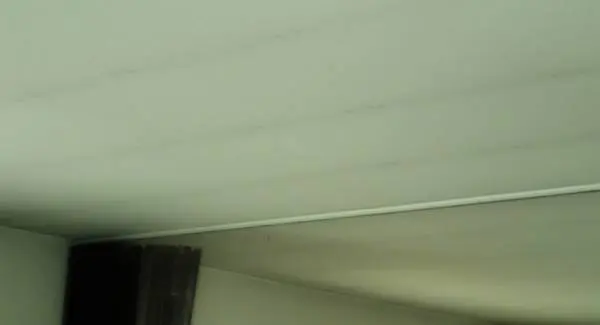
Ghosting on the ceiling
Ghosting from cigarette smoke:
Cigarette smoke can cause staining via the same principle as ghosting. The soot attaches to cold spots on the ceiling. In this case, it was due to areas of missing insulation in the attic. Cleaning soot from ghosting is extremely hard. Typically your only recourse is to repaint.
Mold growth:
Ceiling mold growth is typically black. If you look closely, you can often see the filaments from the fungal structure. Mold growth also requires higher humidity/moisture than ghosting.
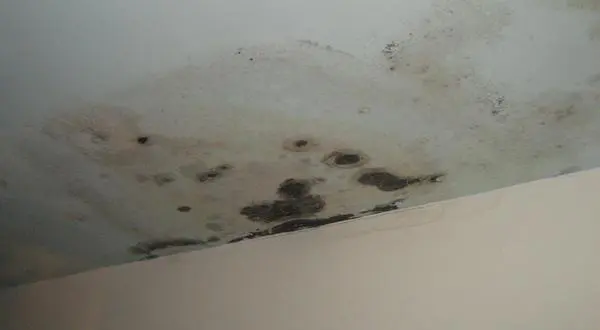
Heavy mold growth on the edge of a ceiling
Identify the cause of ceiling mold growth
Common in older homes, excessive humidity and poorly insulated ceilings can lead to mold growth on ceilings. Mold growth due to humidity (as opposed to liquid moisture) is often identifiable by the growth pattern. A trained professional can usually diagnose the cause of ceiling mold with just a quick glance. The following are clues for each of the moisture source.
Symptoms of humidity based mold growth:
- Mold growth is worse at the perimeter of the room
- The room is on the top floor
- The attic is poorly insulated
Symptoms of mold due to roof leaks:
- Discoloration is brown/yellow
- Mold/staining follows as circular pattern
- Mold growth is confined to a single region
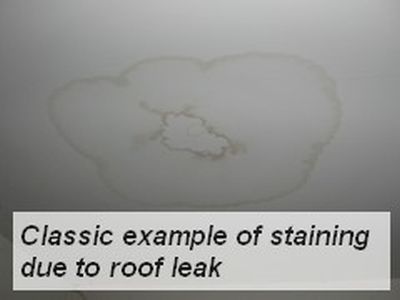
- Discoloration is brown/yellow
- Mold/staining follows as circular pattern
- Mold growth is confined to a single region
Identify the extent
Condensation based ceiling mold:
If the mold growth is due to elevated airborne moisture, the extent of the mold growth will be readily discernible from the interior of the home. Just stand in the middle of the room and look up. If you don’t see mold, there won’t be mold on the other side of the ceiling. Mold testing is often recommended in these situations.
Liquid based ceiling mold:
The opposite is true for roof leaks, pipe leaks, etc. Far more mold growth may be present on the backside of the sheet rock than the side facing the room. A visual inspection of the backside of the ceiling is the only way to properly identify the extent of the mold growth.
Unusual scenarios
Occasionally we encounter a noteworthy project that creates unique challenges. Often these are due to mold problems in specialized buildings. In this case, the water loss and mold damage occurred in a dedicated media room. While entertaining for the home owner, home theater rooms always present difficulties due to the sound deadening materials used in the ceiling and wall cavities. In the diagram below you’ll notice several unusual items. 1.) Inner floor insulation. 2.) Additional layer of particle board. 3.) Upholstered fabric
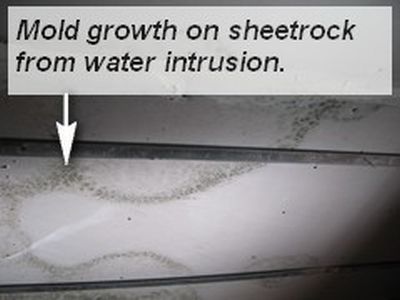
Dryout of this ceiling/floor system required far more work than typically called for in a water intrusion. As you can imagine, once moisture enters the interior of the ceiling cavity, it won’t readily leave.
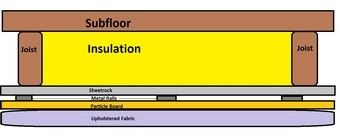
Remediating mold growth in ceilings.
First, identify whether or not the ceiling in question contains insulation. If the ceiling is on the top floor of the home, it is likely insulated. One caveat: top floor ceilings may lack insulation if the attic insulation is located on the roof sheathing. However, this is an unusual arrangement. Inner ceilings are typically uninsulated. Exceptions to this are occasionally found when a second floor was installed at a later date. Also, some homes have insulation on interior ceilings for sound reduction purposes.
Uninsulated, inner-building ceilings are both less likely to support mold growth and easier to remediate if mold growth does occur. If you’ve spent any time on this site you know that mold growth requires both a food source and available moisture. Sheetrock, especially the paper on the backside is an especially welcome food source for mold. Thus, we’re left with moisture as the controllable factor. This is where uninsulated ceilings show their advantage. Because they lack insulation, air is free to move on both sides of the sheetrock, allowing dryout to occur much more rapidly. Additionally, if mechanical dry out techniques are necessary, such as dehumidifiers and air movers, the free air allows for exponentially faster moisture removal. Remember though, we’re not talking about uninsulated top floor ceilings.
Replace or repair?
The first choice encountered in a ceiling remediation project is simple. Is the ceiling material salvageable or does it require replacement? In general, if the mold growth is due to liquid water intrusion (i.e. roof leak), replacement is recommended. If the mold damage is due to condensation, the ceiling can often be repaired without replacement.
Remediation.
If replacement is warranted, contact a professional mold remediation company. Removing a ceiling can introduce a tremendous quantity of mold spores into the indoor air, and thus, containment is necessary. If cleanup is appropriate, small jobs under a couple square feet may be undertaken by a homeowner.
*Heads up – I earn a small commission on sales through Amazon links. This helps cover the expense of running the website (and answering your questions!)
Got a question? Ask it here and we'll post the answer below
"Hello...we had insulation blown into our attic. We are concerned if there was mold before the insulation was installed. How do we check that. "
It’s very unlikely mold would grow beneath the insulation. Condensation is the most common cause of mold growth in an attic. Condensation occurs on the underside of the roof sheathing, not beneath the insulation. Mold growth beneath the insulation would require a roof leak, which you’d typically notice on the ceiling inside the home before any real mold growth occurred.
During Hurricane Harvey the paint and sheet rock on the ceiling in our guest bathroom began to peel and crack. We looked in the attic and discovered the roof was leaking through the nails holding our shingles in place. Now we have spotted what appears to be mold spots adjacent to the cracks in the ceiling. Any suggestions???
I would first verify you actually have a leaky roof. Drips from the nails are often due to condensation. Because the metal nail is the coldest part of the roof, the water will condense on the nail first. Check to see if the water on the roof sheathing is uniform throughout the attic. If so, it’s likely condensation. If it’s limited to specific areas of the roof, it’s likely a failure of the roof shingles.
You mention mold spots adjacent to the cracks in the ceiling. Are these spots in the attic or in the ceiling itself?
I have a 3 story home with an attached garage off to the side which has it's own roof above and inside my garage I'm seeing mold in two different areas but no water stains at all. Any clue why?
Mold in a garage is fairly unusual. Are you seeing mold on the ceiling or somewhere else? What region of the country are you located in?
If the mold is on the garage door, it’s due to condensation from excess humidity in the winter. Installing a low-CFM constant flow bath fan in the exterior wall will solve the problem.
If the mold is on the ceiling, I recommend investigating it as a roof leak. Mold due to condensation is very unusual in the garage because there is typically no moisture source (as opposed to the occupied portion of the home).
Hi, There are small black mould spots stains not too far away from the centre of our bedroom ceiling. Are these as a result of issues with attic above or condensation, many thanks.
There are 3 potential options: roof leak, condensation, or ghosting. Roof leaks are usually obvious because eventually you’ll see an actual drip. However, a very slight leak can cause mold growth without leading to actual dripping. Does the ceiling feel wet to the touch? If you have access to a moisture meter, scan the suspected area. The more likely cause is condensation. This can be due to inadequate insulation in the attic (which can be verified by the unpleasant task of crawling to the area above your room). If you see missing or insufficient insulation, simply add a fiberglass batt.
Excess humidity can also cause mold growth on the ceiling, even in a well insulated attic space. Purchase an inexpensive RH meter and monitor the humidity levels in the room. The 3rd potential cause is ghosting, which is not actually mold (though it can look very similar). Ghosting occurs when small soot particulates from candles, fireplaces, etc. collect on damp areas of the ceiling. This occurs on cold spots, such as areas with missing insulation. It is not a health issue and can be corrected by lowering the humidity inside the home and/or adding insulation to the attic.
Can I spray bleach and wipe off little green mold spots that appear in my living room ceiling?
Yes, but it’s critical you determine the cause of the mold growth. See the answer above for the 3 potential causes of mold growth on the ceiling.
Hello, we have black mould on the wooden framework of the bedroom window which has been there for over a year. I have used Ronseal mould killer on it but the mould path is still there. Are these harmful in terms of emitting mould spores or are they just stains/patches?
Mold growth often leaves behind stains in the underlying material. This is due to the pigment produced by the hyphae as it grows into the wood. Assuming you’ve thoroughly cleaned the wood, this staining is harmless and merely an aesthetic nuisance. Removing the staining requires sanding or heavy chemical usage, both of which will harm the finish of the wood. I only recommend trying to remove the staining if you plan on refinishing or repainting the piece of wood.
I gutted and remodeled our bathroom and ended up attaching a layer of green board to the sheetrock that was on the ceiling. I did not want to disturb the 14 inches of blown in insulation that was in the attic over the bathroom. Now, 23 months later (and 11 months since family moved back in that take HOT shower everyday in that bathroom) we are getting a mildew odor in the room. Can a double layer of sheetrock over a tub cause mildew/mold to grow between them?
It’s highly unlikely mold would grow in between the two layers of sheetrock. If condensation were to occur, it would appear on the surface closest to the warm, humid air (the green board in your case). Must odors are common in bathrooms with insufficient ventilation. I recommend installing a Panasonic WhisperGreen or wiring an automated timer switch to your existing fan.
In my bathroom, the light fixture is not working. So no light gets in at any time. I recently noticed a very musty smell, which is also throughout the house. I would like to know if my health is at stake. Thank you for your patience in reading this message.
The lack of light in the bathroom would not directly cause the mold growth. The main cause of mold on a bathroom ceiling is a broken or ineffective exhaust fan. I recommend replacing the fan with a constant flow unit such as the Panasonic WhisperGreen fan. Here is a link. If that’s outside of your budget, you can install a timer switch on the existing fan. Run it at least 12 hours/day in the cooler months.
What's this on my bathroom ceiling. I wiped it off and saw no opening. What should I do next?
This appears to be mushroom type of fungi. Typically these only grow in highly saturated materials, i.e. from a water leak as opposed to humidity. A mushroom growth on a ceiling is quite unusual. This type of fungi requires significant nutrients, which often come from soil or rotting wood.
I would thoroughly investigate the area above the ceiling and look for a water intrusion. A moisture meter would be very helpful for investigating the source and extent of the leak. See if you can rent one locally.
Can you identify what is causing this please?
It appears high levels of humidity are leading to extreme condensation on the ceiling and walls. If you live in a hot/humid climate, ensure your A/C is working correctly. If you live in a cool climate and this occurs in the winter, increase your ventilation dramatically. Run the bathroom exhaust fan 24/7. Monitor the relative humidity – your goal is to keep it below 50%.
Hi. We are looking into purchasing this home in VT. Sellers say this addition (lofted area above kitchen) was put on in 2007. No one has lived in the home for 3 years. They believe the mold was caused from high humidity and no dehumidifier. I’ve been researching and everything I read says not to use recessed lights on cathedral ceilings. There is a newer metal roof but I do not see any soffits or vents. The downstairs now has mold on the furniture and walls, but I can wipe it of with my hand. Any suggestions?! Thanks
The mold growth is quite heavy for humidity alone. It’s possible, but it would require an extraordinary amount of moisture – i.e. long term water leak below. It would be highly unusual for a vacant home to accumulate this much mold growth without an active water/roof leak.
One possibility is dripping from condensation in the roof assembly. An unvented metal roof with can lights below can become completely saturated. In severe cases, this can drip down onto the ceiling. Note, this would only occur in an occupied home. Either way, I recommend identifying the type of insulation they used. Also, make sure the can lights are AT (air tight) rated. Additionally, look for rubber gaskets on the trim rings. This case is significant enough to warrant a professional inspection.
A tree fell on my house recently and when we had builder go in the attic to do repairs they discovered mold. WE had the whole roof replaced and were getting a ventilation fan installed. When the mold people came out after the house roof was replaced, they said the mold had gotten worse! Some say its because we have a lot of fish tanks in the basement, and heat lamps for pets on the second floor. Others say its cause the roof is leaking, some say it’s because of a leaky pipe. How do I find the cause? is there a company that will determine the cause? I need to find out!
Fish tanks can be a major contributor to mold growth. They add a large amount of moisture to the indoor environment. Due to the stack effect, this moisture migrates upward through a home, and eventually into the attic. The heat lamps are not a problem. If you plan on keeping the fish tanks, ensure you have continuous exhaust ventilation on the top floor of the home. This can be accomplished with a constant flow fan such as the Panasonic WhisperGreen.
These issues are often due to a combination of factors. In your case, the roof might be under ventilated as well. Often a single vent fan is not sufficient. I recommend verifying that the entire roof is well ventilated. Check out our page on attic ventilation.
The landlord of the building says the brown particles on the bathroom ceiling are dust. How can you tell if it's mold?
A simple tape lift mold test can determine if it’s mold. Here is an example. Mold growth on a bathroom ceiling is nearly always due to inadequate ventilation. If you have a working bath fan, I recommend installing a programmable timer switch. This will toggle the fan on and off throughout the day. If no fan is currently present, install a Panasonic WhisperGreen fan. These run continuously on a low speed mode and ramp up to full speed when the bathroom is occupied.
If it’s a leaking roof is it covered by insurance?
Coverage in this scenario is highly dependent upon your insurer and the individual adjuster assigned to your case. In general, mold is excluded from insurance coverage because it is not the result of “sudden and catastrophic” causes. For example, insurance will cover roofing damaged by a severe wind storm, but it will not cover a leak from an aging, poorly maintained roof.
This doesn’t mean that insurance will never cover mold damaged materials. It just changes how you approach the claim. Whenever dealing with insurance companies, it’s critical to emphasize the water damage, not the mold. Even if the sheet rock has mold growth, focus on the damage from the water exposure (i.e. swelling and delamination). The mold growth is incidental. Even without it, the sheet rock (or carpet) was damaged by the water exposure. Otherwise, unscrupulous adjusters will attempt to deny a legitimate claim based on the presence of mold.
Hi. I've been having problems with one of my upstairs bedrooms. There has been multiple yellow drips above the window. A week later they turn to mould. Clean it off with mould spray and the same thing happens again. Insulation has been fitted in the past few months but it is still occurring.
Was it occurring before the insulation was installed? There are a couple of potential causes. Often the insulation is pulled back from the soffits to allow for proper air flow. This creates a cold spot in the last 6 or so inches where the ceiling meets the exterior walls. If a home has elevated humidity (over 50-55% in the winter), condensation and mold growth can occur. Running the bathroom exhaust fan throughout the day can greatly reduce the relative humidity in the home. Also, ensure the insulation contractor placed insulation as close the edge as possible (without covering the soffit vents). A scan with a thermal imaging camera will readily show whether this is occurring. You’ll see an obvious blue (cold) spot in the exact location of the moisture and mold growth.
The other possibility is a roof leak or gutter issue. If you live in a snowy, cold climate, ice damning can also cause an issue like this.
Is there a paint that resists bathroom mold?
The type and quality of paint can make a big difference in bathrooms. Don’t use a matte finish, they absorb too much water. The higher the sheen the better. Also, look for paints with an additional mildicide. Exterior paints often work well because they are intended to endure wet conditions. Lastly, installing a constant flow fan such as a Panasonic WhisperGreen can dramatically reduce (and usually eliminate) any mold growth in the bathroom.
Looking at purchasing a home that has mold on ceilings and floors. Home was unoccupied. Is structural integrity likely damaged?
Mold itself is not likely to cause structural integrity losses, especially to larger lumber such as studs, joists, etc. However, the same moisture conditions that cause mold growth can eventually cause wood rot. In general, wood root requires higher levels of moisture over a much longer period of time. While mold can growth within days, rot typically requires months of saturation. I recommend verifying you’re solely dealing with mold. If so, you’ll likely have sheetrock, insulation and flooring repairs, but the framing should be sound.
This showed up in the corner of the top floor bedroom of our townhome. The opposite corner shows very mild similarities but the bottom corner of our skylight is quite similar. The lines are straight and a perfect square formed in the center which I wiped a bit before snapping a photo. What do you think?
The sharp lines are caused by changes in the insulation levels in the area above. The same phenomenon causes ghosting, which can be seen in the image at the top of the page. Condensation is higher in areas of poor insulation. This can be due to thermal bridging on the framing or simply a lack of insulation in a particular area. Over time the condensation leads to mold growth. This temperature difference can be readily observed with a thermal imaging camera, which will show a corresponding cold spot in the exact location of the mold growth.
The solution is two-fold. Lower the humidity in the home and improve the insulation in those areas. If they’re inaccessible, direct all of your efforts toward lowering the humidity. Depending on your climate this can be accomplished by either running your bathroom/exhaust fans more often via a timer switch or utilizing your A/C unit.
We live in a rental which has two half baths with a shower room between them. The fans are in each half bath rather than the shower room. We keep one of the shower room doors open while showering and leave the fan in the adjoining room running for several hours after. Today, I noticed these spots on the shower room ceiling. I couldn’t see them with the light on so I have no idea how long they’ve been there. I’m fairly certain this is from condensation. The ceiling texture makes it difficult to see the extent of the growth. Is this safe to clean, ourselves?
Yes, this is safe to clean yourselves. The growth will likely reoccur due to the distance of the exhaust fan. However, this amount of mold growth is not enough to cause health issues.
Can a small portable oil diffuser be the cause of mold in the corner of the ceiling above location of diffuser?
No, but the particulate released by the diffuser can certainly cause staining on the ceiling. As indoor air quality specialists, we’re a bit uncomfortable with diffusers (or candles for that matter). You’re pumping something unnatural into the air and subsequently breathing it. The oils themselves may be natural, but the inhalation of them is not. Use good judgement and don’t overdo it.
Hi! Since March 30, we've noticed some weird staining occurring on the walls and ceiling throughout our apartment. They all start out as clear then some changes colors. I reached out to our property management on March 30 and again on May 7 because now my entire house is sick and showing symptoms associated with mold exposure. My landlord had yet to come out to determine if it is mold. I'm growing frustrated for obvious reasons and I have been searching the web for insight into what this staining might be. I can't get anyone to come out because that process needs to be initiated by our landlord which has been unresponsive to this point. My question is..based on pictures could this be either ghosting, condensation or mold?!
This type of staining is typically due to heavy condensation. You see it most often in a bathroom. It can also occur in rooms with high humidity and poor ventilation. The condensation is leaching out chemicals/contaminants from the paint. Ghosting causes perfectly straight lines which correlate to the underlying framing. Examples of ghosting.
I would like to know if this is due to condensation or maybe a issue inside my ceiling? Also is it dangerous to breath in and how should I get rid of it. Thank you!!
This is very likely due to condensation. Assuming this is an exterior wall, this is the coldest part of the room. The insulation in the ceiling above is often pulled back from the perimeter to allow air to enter through the soffit vents (or simply because there isn’t much room). This creates a cold spot. Condensation occurs when the warm & humid air interacts with this cold surface. In time, mold growth occurs.
The amount of growth appears fairly small and can likely be cleaned with a detergent/water solution. Some staining may remain which will require repainting.
Preventing regrowth can be accomplished by lowering the humidity in the home and installing more insulation in this portion of the attic. If soffit vents are present, be careful not to block these with the insulation.
Is this ghosting? I just moved into a unit above a garage with poor ventilation.
Yes, this definitely looks like ghosting. The light grey/black pattern shown in your photo is very typical of this scenario. This occurs from a combination of insufficient insulation and elevated humidity. In a vaulted section such as shown in the photo, I recommend focusing on lowering the indoor humidity. A constant flow exhaust fan in the bathroom can be very effective.
I noticed mold on my daughter bedroom ceiling. What is likely the cause? The house is 5 years old and fully insulated and vents in the windows. Any solutions?
This is likely due to insufficient ventilation in the room. While the holes in the windows can help, most homes require more active ventilation. If you live in a climate with cool winters, simply running the bathroom exhaust fan can help quite a bit. A modern, well sealed home requires quite a bit of ventilation. You’ll likely need to run an exhaust fan 12 hours per day. Ideally, this should occur periodically throughout the day, rather than 12 hours straight. A programmable timer can help achieve this.
If the fan is old or loud consider replacing it with a Panasonic WhisperGreen unit. These run constantly at half speed and ramp up to full speed when the bathroom is occupied.
If the mold growth reappears, check the attic space above. Often mold growth on outer edges of the ceiling is due to insufficient insulation in those areas. The cold air entering the soffit vents causes condensation to occur on the ceiling below.
Moldy from roof leak when it was raining and has been like this for about 2 years. Is there anyways this is fixable without replacing the ceiling or will the whole thing have to be replaced?
Based on the limited size of the growth, it can likely be cleaned and repainted without removing the sheet rock. Some mold growth will likely remain on the topside of the sheet rock, but this will not affect the indoor air quality.
Hi, I have mould coming through on the bedroom ceiling - across the coving. It doesn’t feel damp but it’s getting worse. The house isn’t very old (28 years) and the loft is insulated. What would you recommend please?
If you have access to the attic above, inspect the area for a leak. Pull back the insulation and examine the backside of the sheet rock (where the mold was observed from below). If no mold is found, the problem is likely from indoor humidity. I recommend purchasing a relative humidity gauge (hygrometer). The indoor RH should not exceed 50% during the cool months.
Is this mold? If so, what do I need to do and how can I prevent this from happening again. This is in my 1st floor dining room. Directly above this room is my laundry room which has tile flooring. I don’t see water damage in the floor.
Yes, this looks like mold growth. It’s likely from a slight leak from the laundry room above. If you don’t see damage on the floor, it is coming from the supply or drain lines in the wall. I’d check for leaks around the shutoff valves (where the water supply comes out of the wall). I also would check the drain line where the waste pipe goes into the wall.
Could this be the roof or window issue? Recently had windows changed and came back again?
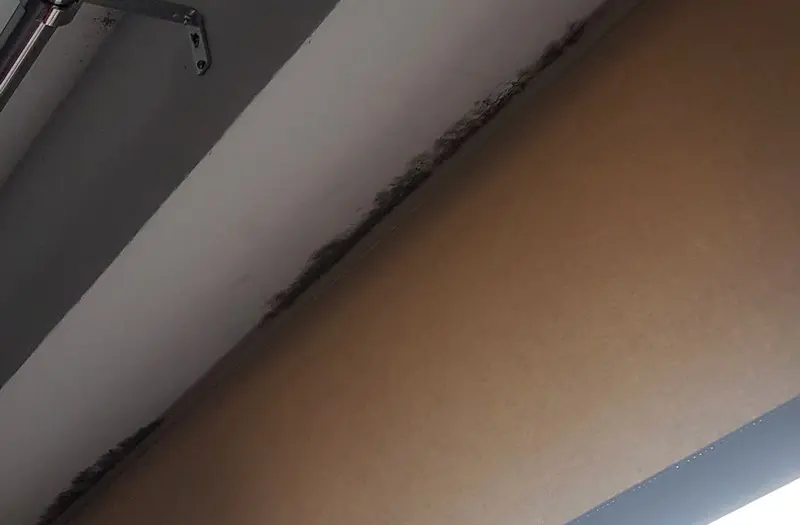
The easiest way to verify this is with a moisture meter. Way until you’ve had significant rain, then run a moisture meter over the area. Moisture from condensation will typically not show up on a moisture meter. However, if it’s from an actual leak, it should register as wet.
Hi, I have mould growth in a bedroom ceiling and need to understand the cause.
This is likely due to a combination of inadequate ventilation and poor ceiling insulation. In the short term, run the closest bathroom exhaust fan at least 12 hours per day. You can install a programmable timer switch to help automate this. If the fan is old and noisy, replace it with a Panasonic WhisperGreen fan. This will lower the humidity throughout the home and help eliminate the mold growth on the ceiling.
Though unlikely, there’s a chance it is due to a ceiling leak. A moisture meter can help verify this (make sure you test it after it’s recently rained).
Hi, we moved into our house 15 years ago. In the the second story of the house there was a storage / closet room that had only insulation. No dry wall. The insulation was flat up against the inside of the roof and I began to notice condensation, dripping and light gray mold on the insulation. I had some left over new insulation and dry wall from another room so I decided to tear out the old insulation and replace it with new. I researched the problem and found that a spacer between the insulation and the inside roof ceiling could help. I used a styrofoam spacer then replaced the insulation and used scraps of drywall to close in the room. Now the mold I back near the peak of the ceiling. Any ideas?
I’m not sure I completely understand how the ceiling was constructed. You do not want a gap between the dry wall and the insulation. You do want a gap between the top of the insulation and the roof sheathing (assuming you have a vented roof). This gap is necessary to allow air flow along the underside of the roof.
Depending on your climate, a gap alone may not suffice. In climates with cool/humid winters, condensation will often form on the underside of the roof sheathing. During cold weather, this can drop down on top the sheet rock below, causing mold growth.
One of the best ways to prevent this is by lowering the humidity in the home. This greatly reduces the odds of condensation on the roof sheathing.
Hi, we are meant to be moving home soon. When we viewed the house in October, we noticed a leak and they said they would have someone out to fix the issue ASAP. The leak was coming from the toilet and the water had spread to the ceiling below. Now in February we have gone back and the leak has only just been fixed, and the flooring was still wet. There is now mould growing in the area on the ceiling downstairs. What are our options? Is it likely the drywall and the structural supports need replacing? Thank you.
Yes, the ceiling (sheetrock) should be removed. The framing behind it is likely intact. It takes quite a bit of sustained saturation to structurally compromise a floor joist. The mold growth can look quite bad and yet not affect the strength of the wood. You’ll know if the wood is compromised – it will crumble or deteriorate by simply poking it with a screw driver.
Today when my kid was playing with a balloon it hit the living room ceiling and curiously I went near to check what is going on in ceiling, a less than 1cm of the ceiling fell and it was very soft. I felt surrounding felt one more place soft as well due to wet. I don't see any ceiling texture change or smell as well. Exact above this location there is a toilet, but didn't notice any leaks in the toilet. Please guide what it would be.
I recommend renting or buying a moisture meter. This is the only way to conclusively determine if you have a leak. Based on the location of the mold/wet spot, you likely have a very slight leak from the toilet seal. This is quite common. Due to the limited size of the damage, I would not recommend removing the ceiling. Instead, replace the toilet seal and monitor for future leaks.
I have a mobile home with a new roof. Since the roof was put on i now get mold on the ceiling they say the roof is not leaking. What is it from
The only way to prove whether it’s a roof leak or something else (i.e. humidity) is by using a moisture meter. I recommend renting or buying one and testing the area of mold growth. Wait until you’ve had recent rainfall to ensure you’ll find the leak. If the moisture readings look normal (<20%), you’re likely dealing with a condensation problem due to elevated humidity. Depending on your climate and the time of year you’re seeing the issue, the solution is typically improving your ventilation or running your air conditioner. Check out our page on humidity & mold problems.
We have mold growing on our bathroom ceiling on the outside wall.
This growth is likely due to excess humidity and poor insulation. The warm, humid air from the home is contacting the cool spots in the ceiling. This leads to condensation and mold growth. Install a high quality bathroom exhaust fan such as the Panasonic WhisperGreen. Depending on accessibility, add insulation above this area in the attic.
I had some light ceiling mold that we cleaned if with Clorox wipes. We now want to paint. We had a glossy paint but wonder if we should apply some sort of primer first or is the application of the glossy paint sufficient?
If there is lingering staining present, use a stain blocking primer such as Kilz. If not staining is visible, a primer is not necessary.
This is a picture of the mold before cleaning the black stuff is it humidity or roof leak related?
The pattern of mold growth and brown staining indicates a roof leak, not condensation. While there are exceptions, humidity based mold typically does not have the brown water stain marks you see in your photo. Also, condensation based mold tends to be less intense and more diffuse. The mold growth on your ceiling is highly localized and fairly heavy. There are also areas of bubbling in the sheet rock, which indicates liquid water.
Hi, we just had popcorn removed from our ceiling and discovered this huge stain underneath it. The contractor said it looked like fire damage to him, but he wasn't sure. Does this look like fire damage or mold? It's directly opposite the oven/stove in the kitchen, so fire could be a possibility, but there's no record of a fire in this unit according to building management. Thank you!
This is a tricky one. Based on the photo, this does look more like fire damage than mold growth. If it is mold, it has long since died or become inactive. I would simply paint it with a stain blocking primer. It will not cause any ongoing health exposure issues.
Is this mold this is in a Bathroom on the ceiling and wall this is a cement block house that is not insulated
Yes, this looks like mold growth. Your best approach, short of insulated the home, is to lower the indoor humidity. This will reduce the likelihood of condensation and mold growth. If you live in a cool climate, this can be accomplished by increasing the heat in your home and raising your ventilation rate. Often the simplest way to do this is via a constant flow bathroom fan such as a Panasonic WhisperGreen.
If you live in a warm/humid climate, you’ll need a dehumidifier to lower your indoor humidity.
Can this be cleaned with bleach and paint? Or does it require replacement? It is the ceiling in the attic conversion room.
The level of mold growth is pretty severe. In most cases, this would warrant replacement of the ceiling. Identifying the cause is the key issue here. Based on the widespread nature of the growth, this is likely due to heavy condensation. This is caused by a combination of poor attic insulation and inadequate interior ventilation. If you have an existing bathroom fan on this upper floor, run it 24×7 during the winter months. If there’s no current ventilation, you’ll need to install a unit.
We have an area in our home which has a high ceiling with no attic. All was well with the old composite roof, but we had a metal roof installed and the ceiling plaster began to develop mold which emulated from the exposed beam and showed the outline of the studs. What is the remedy for this condition?
This is almost certainly due to poor insulation in the cavity between the ceiling and the roofing. The clue is the pattern of mold growth. Notice how there are lines without mold that correspond with the framing. In this case, the ceiling cavity is poorly insulated and the framing is offering a better r-value the the insulation. Usually the opposite occurs and the mold growth occurs in a line corresponding to the framing.
There are two solutions. First, dramatically lower the relative humidity in the home. Assuming you live in a climate with cool winters, this can be achieved via increasing your fresh air intake (i.e. a constant flow bathroom fan such as the Panasonic WhisperGreen). The second option is very costly. Remove the roofing and install rigid foam/spray foam insulation. High density cellulose can also work in certain applications.
Hi; I’m looking at purchasing a house but have found these mould issues. Re you able to offer any advise? Thank you.
This mold growth is almost certainly due to excess humidity inside the home. Thankfully, this mold growth only impacts the interior facing side of the sheet rock. Therefore, it typically does not require removal. Preventing regrowth will require lowering the indoor humidity and improving your attic insulation.
heck out our bedroom ceiling after we removed drop paneling that was used to cover this up. Can’t tell if this is mold, cigarette smoke residue or what? Any input on whether this could be black mold?
This is a bit tricky to determine without testing. I recommend grabbing a piece of the suspicious material and bringing it to a local lab. They should be able to determine if it’s mold growth. If not, your hunch regarding smoke residue is likely correct. Cigarette smoke typically causes yellow & brown staining. The black color of the staining in this photo points more toward mold growth or smoke from a fire.
How do you fix this? This is occurring where the ducts run along the ceiling.
This is likely due to the interaction between the cool, air-conditioned air in the duct interacting with the warm, humid air in the room. Based on the photo, this looks like a garage or basement. Typically your air-conditioner removes excess humidity from the home. Because your garage isn’t conditioned, the humidity will be much higher.
A couple options are possible. If this is a basement, ensure all vents are open and allow the air conditioner to fully condition the space. Ensure your RH stays below 55% throughout the year.
If it’s a garage, you could condition the area, which will lower the RH. However, you’ll certainly feel this on your energy bill. This approach can create other problems by introducing chemicals from your garage into the main part of your home. You’d need to essentially convert your garage to a room in the home and store chemicals, gas, etc. in another location.
Your other option is to insulate the ducting. This will likely require removing a section of sheetrock. If the ducting is sitting directly on the sheetrock, elevate it by inserting rigid foam insulation between the ducting and the ceiling.
We discovered mold in our AC and had an AC company do a full duct cleaning and install UV lights in the duct system. We had found mold on our clothes, in our drawers, and on our walls however they were barely visible (white spots on clothes and on walls a slightly darker hue in circular shapes, spread out). After the duct cleaning was completed, I went upstairs where we usually never go and looked at the shower ceiling to find this! I smell an off smell in that bathroom upstairs right above the bathtub, and I am very afraid that this mold may have penetrated the walls at this point (we cannot afford remediation at all). Can you please tell me if this is a bigger issue than just mold caused by high humidity? I sprayed it with Concrobium and it appears to have gotten rid of it for now.
Based on your description, this certainly sounds like humidity/condensation based mold growth. You need to lower the humidity levels in your home. In your climate (hot & humid), humidity reduction is typically accomplished by your air conditioner. If you don’t have A/C, I highly recommend adding it to your home. If you already have air conditioning installed, the unit is either undersized or failing to strip the humidity from the air. Higher a competent HVAC contractor to evaluate your system. Duct cleaning and UV lights are not a long term answer. Those should not be necessary. I recommend hiring a different contractor to evaluate the system. If the system is properly sized and installed correctly, it should have no problem preventing mold growth in your home.
This began during the transition from summer to fall weather..it has progressively grown slowly over time. It is above the windows and only occurs on one side of our house along the same wall. Any ideas what it could be?
Based on the uniformity of the mold growth, this is likely due to condensation from areas of missing insulation in the ceiling. Notice how the areas without mold growth. Those lines almost certainly correspond with the framing in the ceiling. If this were from a roof or siding leak, you’d expect to a see a more uneven growth pattern.
If you can access the area above (i.e. the attic), check the area for missing insulation. If not, rent a thermal imaging camera and see if the mold growth corresponds with cold spots (wait for cool weather). If it does, you’ll need to either add insulation, or significantly lower the humidity in the house. During the cooler months, this can be accomplished by increasing your ventilation rates. Often the simplest technique is to install a programmable timer on your bath fan such as an Air Cycler.
We have mold growing on the ceiling in both bathrooms and the babies bedroom. It is not wet. We have used kilz on it once before and it covered it for awhile. Now it’s back with vengeance. Any thoughts?
Due to the pattern of the growth this is very likely due to condensation. Water leaks cause mold growth in a single or continuous area. Notice how the growth in the photo stops and restarts a couple feet away. A water leak would not do this. In most cases, this type of condensation is due to a poorly insulated attic space above the ceiling. Inadequate indoor ventilation also exacerbates the issue. I recommend investigating the attic space above and add insulation if possible. You would also benefit from increasing your interior ventilation rate by running your bathroom fan during the winter months (or replace it with a constant flow model such as the Panasonic WhisperGreen).
Have some areas of concern in a fairly new home. This is ceiling in upstairs hallway. Bathroom is adjacent and adjacent bedroom has discoloration around smoke detector/Ac Vents.
Based on your location (Florida), this is likely due to a poorly working air conditioning system. Your air conditioner is not sufficiently removing the humidity from the air. When the cool air from the registers hits the surrounding ceiling, it cools the surface, leading to condensation. Over time, this condensation provides sufficient water for mold growth.
Sometimes this occurs when the air exiting from the register is much colder than the surrounding materials. This happens when the AC is oversized and provides periodic blasts of cold air instead of a steady supply of cool air.
I recommend contacting an AC contractor to investigate your system.
We are purchasing this home and saw this mold area. Is this very concerning and what would cause this? And how do we prevent it. This is a 1905 home and this is the entrance to the basement. The left wall is the exterior sunroom wall, above this room is unfinished attic. No signs of any current leaks. There’s also a little graying spots behind where a washer goes. No spores nothing in that area. But that area is an add on just laundry room.
This is likely due to condensation. The unfinished room above (and lack of heat) is causing condensation to occur on the cool surface of the ceiling. Basements are typically heated less than the rest of the house, which will compound the problem. If possible, insulated the ceiling cavity above. If not, focus on increasing the heat and ventilation in the room. The current mold growth doesn’t likely require professional remediation or the removal of the plaster/sheet rock. Simply clean it and repaint. If the mold returns, increase your efforts on heat and ventilation. I also recommend installing a relative humidity gauge on the wall. Your goal is to keep the RH under 50% in this room during the winter months.

